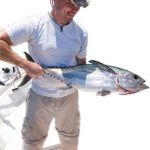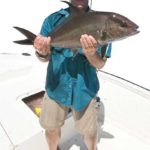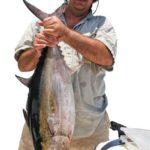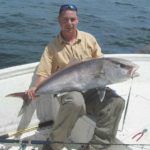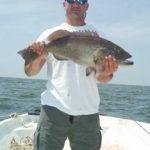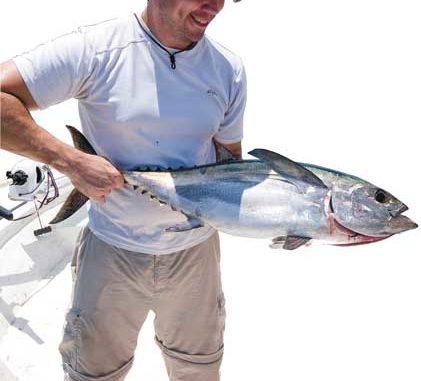
Save some gas on your next offshore trip, and give these often overlooked rigs a try. You won’t regret it.
Craig Monroe eased his 22-foot Triton SeaFlight up to the fish-cleaning dock at Venice Marina.
He slid it right between two large TwinVees.
Monroe, who fishes out of Venice about twice a month, has gotten to know many of the local charter captains over the years.
Monroe asked one of these captains how the bite was that day.
The captain relayed that the blue water was way offshore, and the bite was slow. They did manage to pull in a few nice yellowfins.
The captain asked Monroe how we did.
I went to get the wheelbarrow.
Monroe opened the fishbox and revealed that there wasn’t a cubic inch of room left in it.
Our friends at the dock gasped as we began to unload our haul of amberjack, grouper, beeliners and extra-jumbo blackfin tuna.
“Where did you catch all those fish with that tiny boat?” Monroe was asked.
“At the 7-Mile Rigs,” Monroe replied nonchalantly.
More than one onlooker made note that those rigs are overfished and it’s hard to get a bite out there.
“That’s just not so,” says Monroe, who considers the 7-Mile Rigs his go-to spot for one day trips.
This line of rigs sits on the very edge of the Mississippi Canyon, and it ranges in depth from 450 to 500 feet. The rigs can be found in South Pass 49 and Mississippi Canyon 63.
It also includes an area marked on the NOAA maps as a fish haven. It’s designated as FR-LA 48, and is actually in Mississippi Canyon 63. Once it was just a covered well without any visible structure. Recently new stanchions have been erected there, and the well head now protrudes out of the water.
“You just can’t miss them,” says Monroe. “When you come out of South Pass, head straight southeast for 7 miles. You can clearly see them from the mouth of the river. They are the closest rigs on the horizon.”
The 7-Mile Rigs aren’t often fished by the charter boats. Some boats will stop there to make bait on the way out or stop there on the way in to drop for AJs when the far offshore bite is slow.
The bigger and faster boats used by the charters have the legs to get out to deep blue water during a day trip.
Its locals, like Monroe, who can’t always make it out to the floaters who really benefit from these rigs.
“We’re really lucky,” he said. “There are only a handful of places in this country where you can be in 500 feet of water and still be in sight of land and the shelter of the river.
“It’s a shame that a lot of people claim to have marginal success out at these rigs. I think that’s why they don’t get fished that often.”
Monroe, who fishes these rigs on a regular basis, has developed a series of tactics that net him regular success.
“When we ride up to these rigs,” he said, “we always see the same thing. Most boats will go straight to the downcurrent corner and attach a rig hook. They drop live bait right next to the legs and wait for something hit it.
“Being tied up right next to the rig makes it very difficult to land the fish that you hook. The fish will almost every time take your line into the maze of pipes and structure down there. It’s hard to prevent getting broken or cut off when you’re right next to the rig legs.”
Monroe prefers to drift around the structure and take advantage of not being tied up.
“It never fails,” he said. “We’ll motor up to a rig that has a boat tied up and exchange pleasantries. We’ll ask how the bite is, and then we’ll start looking for the fish and set up for our drift.”
According to Monroe, there’s some work that should be done before you start putting out lines.
“When we show up, the first thing we do is survey the area with the fish finder,” he said. “We’ll usually do a circle right around the rig and use the fish finder to locate all the stanchions. We’ll cut the engines on each side of the rig, and see how fast the current takes us. That gives us a good idea of how far in advance of the target area we want to start our drift.
“If the current is real strong, we’ll use the motor to slow down the drifts.
“Next we’ll start doing circles at 50 yards, then 75 yards and then 100 yards away from the rig. The whole time our eyes are glued to the fish finder.”
Monroe emphasized how important it is to have a good fish finder for these techniques.
“Two years ago, I upgraded my fish finder to a more powerful, color, digital model. I spent a lot of time learning how to take advantage of all its features.
“Even though we’re in 500 feet of water at these rigs, I’ll set the zoom to look at the top 200 or 300 feet. My particular model allows me to then split the screen and just look at a 50-foot cross section of that area.”
According to Monroe, you need to figure out how to interpret the returns.
“Different fish produce different returns, and how they are schooled and at what depth can help you figure out what’s down there,” he said. “Returns that are light around the outside and darker in the center usually indicate a species that has an air bladder, like snapper or grouper.
“If it’s a solid color, it’s usually an amberjack, an almaco or another bladderless fish.
“How quickly a return changes depth can give you a hint as well.
“When you see a large pocket of multiple returns that are light-colored but solid and look like snow, you’ve found the baitfish. Look for the larger returns mixed in to know if something’s feeding down there.
“Every model of fish finder is different, so you need to experiment and learn what returns indicate what kind of fish.”
Monroe has so much practice at reading his fish finder that he can almost immediately tell the difference between a school of hardtails, a school of tuna and a school of snapper.
“Depending on what we are targeting, we’ll set the boat up so that it is well upcurrent of our target area,” he said. “Sometimes we’ll be 200 yards from where we want our baits and tackle to be.
“The currents out here can vary throughout the year. Most of the time they are pretty strong, and the surface current caused by winds might be pushing the boat in a direction different from the stronger underwater currents.
“Like most all of the rigs in our area, these rigs branch out like Christmas trees toward the bottom. Different species seem to prefer different parts of all this structure. For the deeper reef fish, you can find them where the stanchion juts out and intersects with the 250- to 300-foot line.
“Blackfin, on the other hand, will stay on the move in schools between 50 and 150 feet. Because they are always on the move and because they may not be on the surface, a lot of boats don’t realize they’re there.
“That’s why it’s important to survey the area that far off of the rig. Once you find them, it’s usually not hard to stay on top of them.”
Monroe really loves the diversity of the area.
“There’s a myriad of game fish out at the 7-Mile Rigs, and you just have to be looking for them in the right spots,” he said. “Sometimes that means being way upcurrent of the rig as well.”
Having a competent crew helps ensure bigger catches.
“I always like to have at least one other person on board who can confidently drive the boat,” Monroe said. “That way we can take turns. One person is always ready on the throttle and watching the fish finder to make sure we’re moving with the school or following the larger returns.
“Once we find the returns we’re looking for, we’ll usually start hooking up with fish right away. Oftentimes we’re 50 yards or more off of the rig when it happens.
“This usually results in a call from the other boat to ask what we’re doing, and we’ll try to our best to explain it to them.”
According to Monroe, the real secret is in the tackle and techniques he uses.
“A few years back, while I was living on the west coast, I learned about vertical jigging,” he said. “When I first moved back to Louisiana, it wasn’t real well known yet. I had to buy a lot of my tackle from online specialty shops who imported the equipment from Japan.
“Shortly after Shimano came out with the Butterfly Jigging line, there was an explosion of popularity and gear available.
“Now, all of the local shops carry the gear from a number of top-quality manufacturers.”
Monroe says the 7-Mile Rigs are especially suited to vertical jigging.
“Vertical jigging,” he said, “takes advantage of the fish’s predatory nature, and will induce strikes even when the fish aren’t actively feeding.
“It also allows you to target a number of species in different parts of the water column without having to change out a lot of gear.
“You can work the 400- to 300-foot range for large grouper. You can work the 300-to 200-foot range for AJs and almacos. And you can work the 200- to 50-foot range for blackfin and lane or beeliner snapper.
“You can do all of this without ever taking your jig out of the water. Just keep your eyes glued to the fishfinder and keep your jig at that depth. Work that 50 feet of the water column, and drop it back down again until you get a strike.
“You never need to worry about whether your bait has been plucked, and you don’t have worry about knowing when to set the hook. The fish will definitely let you know.
“You can keep your jig at the target depth one of two ways. You can use a multicolored braided line that changes colors at certain intervals, such as Saltiga Boat Braid or another specialty jigging line, or if your fishfinder is dialed in right, you can actually see the return from your jig falling through the water column. It will look like a thin slanted line across the screen.”
The water quality at the surface of the 7-Mile Rigs varies throughout the year. During much of the year, the visibility in the top 15 or 20 feet isn’t much better than that of the river.
“I think a lot of people are thrown off by that,” Monroe said. “I’d love to be able to get out to where the blue water is, but it usually just isn’t in the cards for a day trip on a smaller, single-engine boat.
“Vertical jigging really shines here because it isn’t affected by the water on top or the amount of baitfish in the area.
“On our most recent trip to the 7-Mile Rigs, the surface water was very brown, but we started hooking up with AJs and almaco jacks so frequently that another boat came alongside to see what we were using.
“They offered us money for a few of our jigs. Sadly, I had to explain to them that in order to really be successful you needed more than the jigs.
“You really need the whole system. You need a short, lightweight jigging rod that’s parabolic, you need a tough reel with a lot of drag and you need the braided line.”
According to Monroe, the initial investment can be a little steep, but if you fish these rigs a lot, you’ll catch more fish.
“When an amberjack or wahoo sees the aggressive darting motion of a vertical jig, you can bet he’s going to go after it,” Monroe said. “It’s instinct.”
Another tip he offers is to use heavier jigs.
“To work the kind of depths at the 7-Mile Rigs with the amount of current that’s usually out here you need jigs that are in the 10- to 14-ounce range. Any lighter than that, and the current carries them faster than the boat.
“You want the jig to be right underneath the boat when you start jigging. This is why we start our drift so far up from the target area. It gives enough time for the jig to get all the way down to where you need it to be and also for the line to straighten out.”
According to Monroe, one common mistake he sees with those who are new to jigging is that they start jigging too soon. You really have to wait for it to straighten out, he said.
Not every day at 7-Mile Rigs is a brown-water day. There are those days in the late summer and autumn when the river is low, currents are just right and there is crystal blue water that close to the river.
“I’m not going to promise anyone that they’re going to catch a 150-pound yellowfin at the 7-Mile Rigs,” Monroe said. “But on those special days, you do find yellowfin that close in. Normally they are the smaller 50- to 80-pound ones. You just never know though.”
It’s also in those days that Monroe keeps a 7 1/2-foot popping rod rigged and ready.
“If you start seeing surface action, you can put down your jigging rod and start throwing big poppers,” he said. “During this time of year, you’ll also get a lot of cobia coming up to check out the boat. You can throw a popper out in front of them and get them fired up.”
Another fish that looks like cobia also likes the 7-Mile Rigs.
“Summer and fall pose one additional challenge — sharks,” Monroe said.
But another advantage of the 7-Mile Rigs is that if you keep losing tackle and fish to sharks, it’s only a short run to another rig.
“For some reason, there might be a ton of sharks on one rig and none on another,” Monroe said. “It pays to just pick up and move.”
During the winter and early spring in the area, you have the opportunity at a lot of wahoo.
“If you’re in a smaller boat that’s not set up for trolling, you can still target wahoo,” Monroe said. “We use the same jigging techniques, only we use a 12-inch section of flexible braided wire between the jig and the shock leader.
“When a wahoo hooks himself with one of these metal jigs, he’s going to really take off. You’ll probably need to chase him down. This is another good reason to not hook right up to the rig.”
Monroe said the 7-Mile Rigs are great year-round.
“I like to keep my freezer full of fresh fish,” he said. “I can’t usually get out to where the big yellowfin are, so I fish what’s accessible to me given the size of my boat.”
